S-Ti covalent bond MXene enhanced tantalum capacitor for ultra-fast sodium storage
QQ Academic Group: 1092348845
Detailed
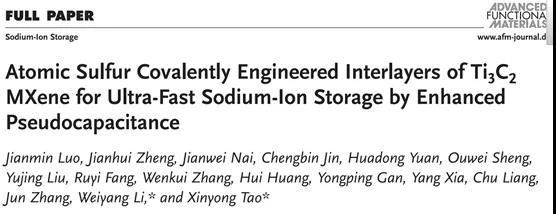
【Research Background】
Sodium ion (Na+) energy storage has a similar working mechanism as lithium ion (Li+) energy storage, and has a significant advantage in the rich element content and low cost of the earth‘s crust, making it a lithium ion energy storage application in large-scale energy storage. An ideal substitute for the field. However, compared to the radius of Li+ (0.76 Å), the radius of Na+ is much larger (1.02 Å), so the volume expansion is greater during energy storage, resulting in a slower reaction kinetics, making it difficult to find a suitable host material for storage. Na+. Therefore, it is still necessary to find a new and efficient electrode material for Na+ storage.
[Introduction]
Recently, Prof. Weiyang Li from Zhejiang University of Technology and Professor Tao Xinyong reported a simple method to embed S atoms into Ti3C2 MXene (CT-S@Ti3C2) pretreated with cetyltrimethylammonium bromide (CTAB). ) between layers. After pretreatment with surfactant CTAB, S atoms are successfully intercalated between the layers of Ti3C2 by forming Ti-S covalent bonds, forming a very ideal interlaminar structure, while Ti3C2 without CTAB is insufficiently surface active. It is difficult for S atoms to be embedded. When the calcination temperature is 450 ° C, the S atom-embedded Ti3C2 MXene electrode (CT-S@Ti3C2-450) has a sodium storage capacity of 550 mAh g-1 at a current density of 0.1 A g-1, and at 10 A g- Excellent cycle stability of over 5000 cycles at high current density of 1.
The results are published online at Advanced Functional Material: Atomic Sulfur Covalently Engineered Interlayers of Ti3C2 MXene for Ultra-Fast Sodium-Ion Storage by Enhanced Pseudocapacitance
[Graphic introduction]
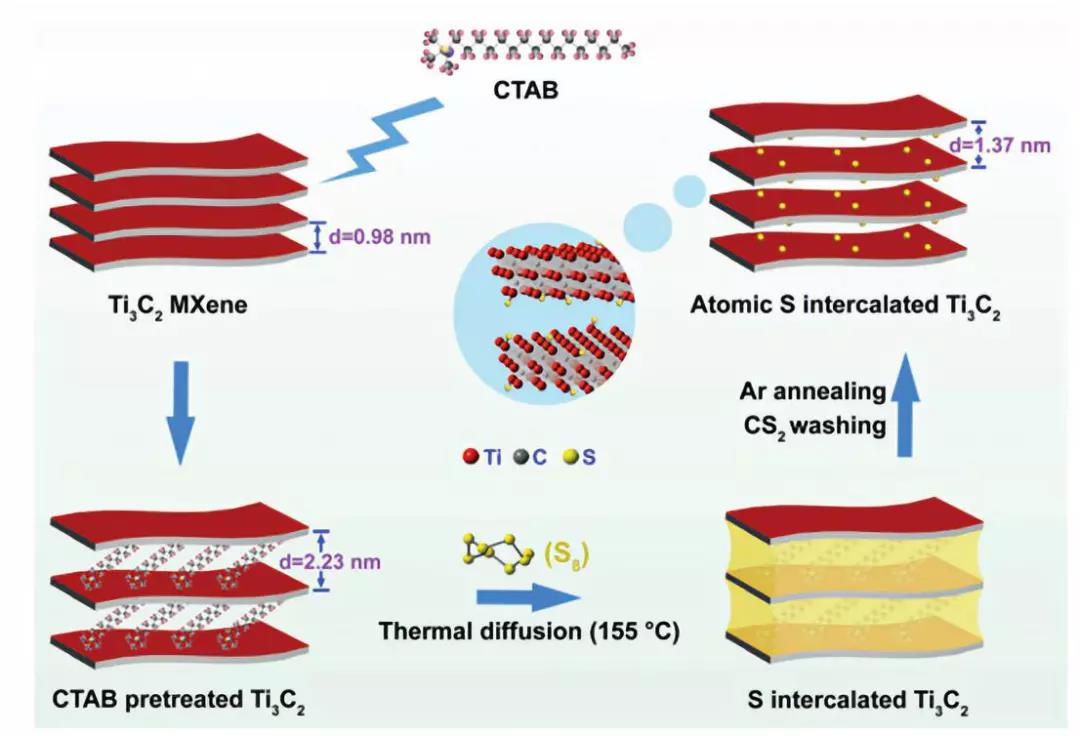
Fig.1 Schematic diagram of the synthesis of S atoms embedded in Ti3C2
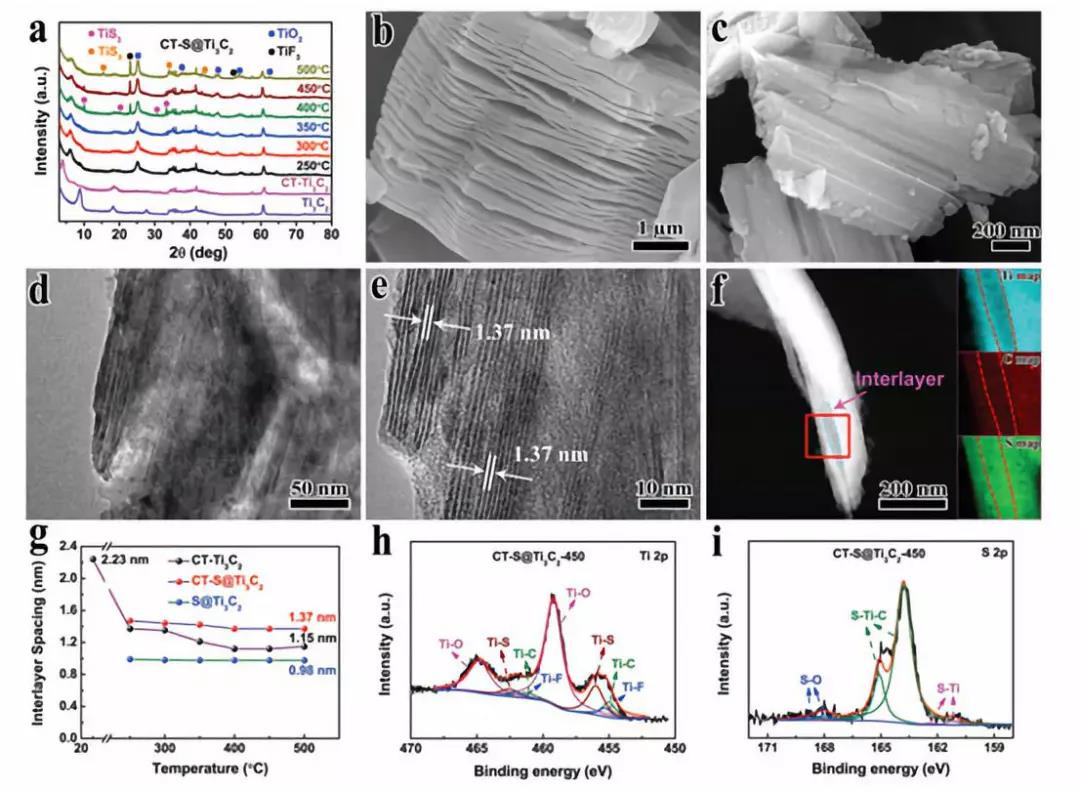 Figure 2 a) SEM image of Ti3C2, CT-Ti3C2 and CT-S@Ti3C2 at different annealing temperatures (250-500 °C); b) SEM image of Ti3C2 c)CT-S@Ti3C2-450; d,e TEM image of CT-S@Ti3C2-450; f) STEM image of CT-S@Ti3C2-450 and corresponding distribution of Ti, C, S elements g) CT-Ti3C2, CT-S@Ti3C2, different annealing The layer spacing of the S@Ti3C2 sample at temperature (250-500 ° C); h, i) Ti 2p and S 2p XPS spectra of CT-S@Ti3C2-450.
Figure 2 a) SEM image of Ti3C2, CT-Ti3C2 and CT-S@Ti3C2 at different annealing temperatures (250-500 °C); b) SEM image of Ti3C2 c)CT-S@Ti3C2-450; d,e TEM image of CT-S@Ti3C2-450; f) STEM image of CT-S@Ti3C2-450 and corresponding distribution of Ti, C, S elements g) CT-Ti3C2, CT-S@Ti3C2, different annealing The layer spacing of the S@Ti3C2 sample at temperature (250-500 ° C); h, i) Ti 2p and S 2p XPS spectra of CT-S@Ti3C2-450.
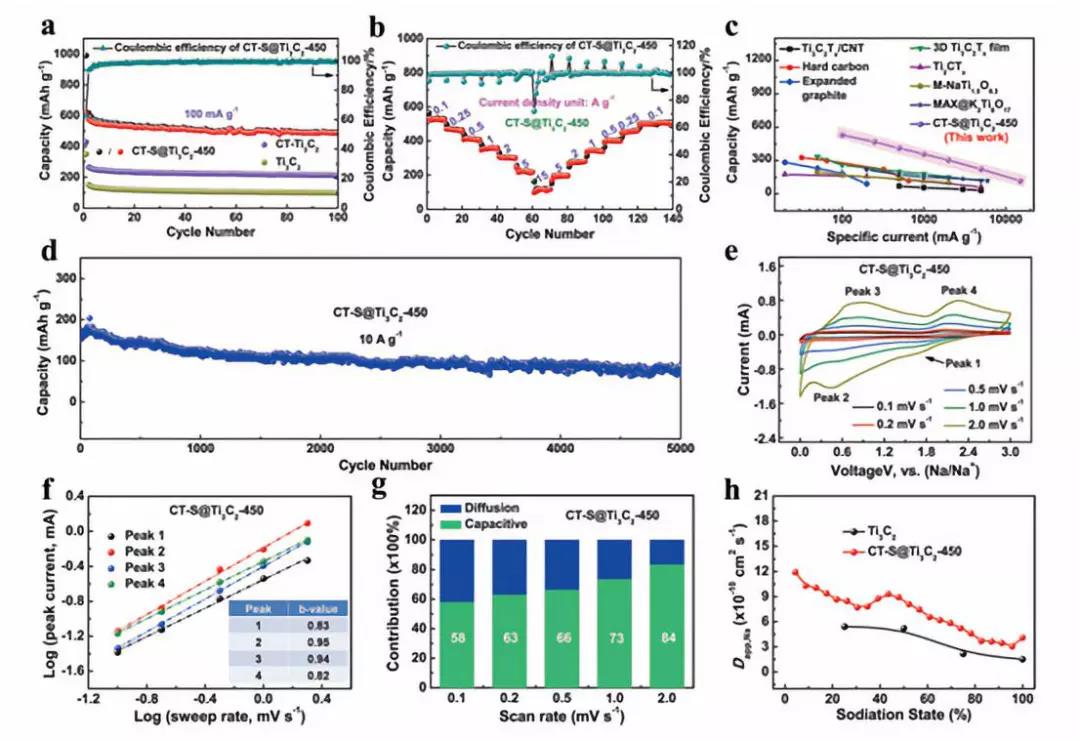 Figure 3 a) Cyclic performance of Ti3C2, CT-Ti3C2 and CT-S@Ti3C2-450 electrodes at 0.1 A g-1; b) Magnification performance and corresponding charge and discharge of CT-S@Ti3C2-450 at different current densities Sectional view; c) CT-S@Ti3C2-450 compared with other reported high performance carbon-based and MXene-based anodes at different current densities; d) CT-S@Ti3C2-450 at 10 A g-1 long Cyclic performance; e) CV curve of CT-S@ Ti3C2-450 electrode at different scanning rates; f) logarithmic relationship between peak current and scanning rate, internal graph: b value calculation result; h) Ti3C2 and CT-S Na+ diffusion coefficient of @Ti3C2-450 electrode.
Figure 3 a) Cyclic performance of Ti3C2, CT-Ti3C2 and CT-S@Ti3C2-450 electrodes at 0.1 A g-1; b) Magnification performance and corresponding charge and discharge of CT-S@Ti3C2-450 at different current densities Sectional view; c) CT-S@Ti3C2-450 compared with other reported high performance carbon-based and MXene-based anodes at different current densities; d) CT-S@Ti3C2-450 at 10 A g-1 long Cyclic performance; e) CV curve of CT-S@ Ti3C2-450 electrode at different scanning rates; f) logarithmic relationship between peak current and scanning rate, internal graph: b value calculation result; h) Ti3C2 and CT-S Na+ diffusion coefficient of @Ti3C2-450 electrode.
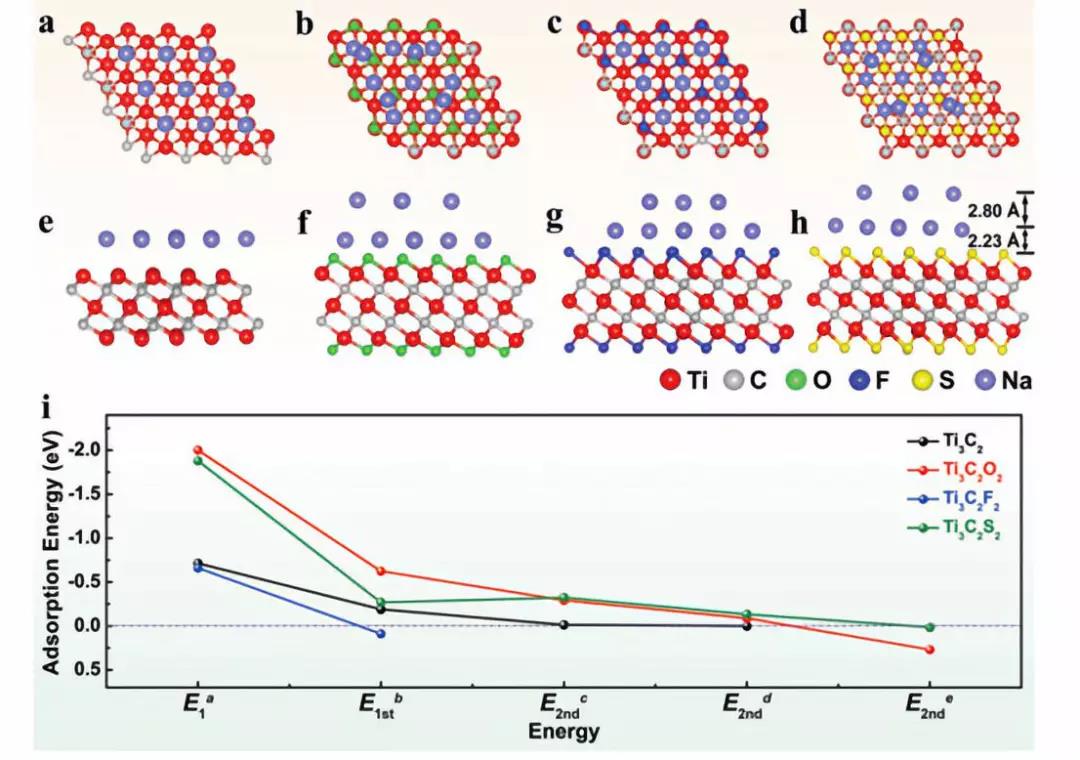
Figure 4 DFT calculation of Na+ adsorption and geometry of the top and side views of Ti3C2, Ti3C2O2, Ti3C2F2, Ti3C2S2 monolayer.
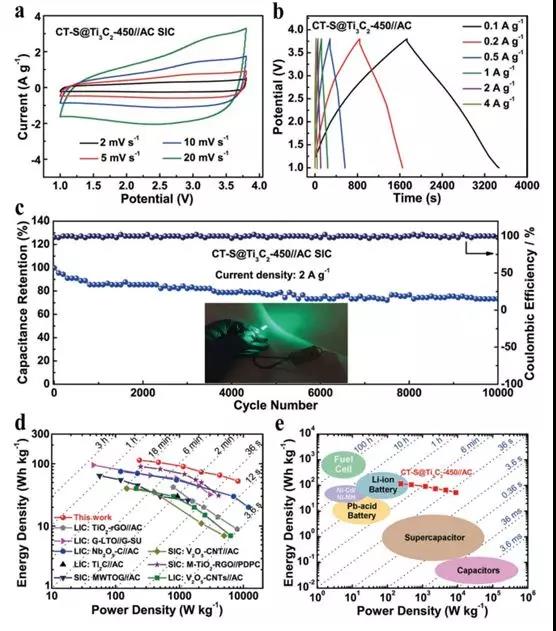
Figure 5 a) CT-S@Ti3C2-450//AC SIC scan rate range from 2 to 20 mV s-1 scan rate; b) CT-S@Ti3C2-450//AC SIC at different current densities 1.0– 3.8 V voltage range charge and discharge curve; c) SIC cycle performance at 2 A g-1; d, e) Rgone plot of CT-S@Ti3C2-450//AC SIC.
[Summary of this article]
Pretreatment of the MXene sheet with the highly effective surfactant CTAB promotes the intercalation of S atoms into the Ti3C2 MXene layer. Due to the effect of CTAB pre-surface activation, S atoms can be successfully embedded in the intermediate layer of MXene. When the annealing temperature is 450 °C, the prepared CT-S@Ti3C2-450 electrode exhibits excellent Na+ ion storage performance and exhibits excellent sodium storage properties of MXene-based materials. The DFT calculation combined with microstructure characterization, electrochemical performance testing and kinetic analysis showed that CT-S@Ti3C2-450 exhibited faster Na+ storage kinetics and a large number of active sites after S atom insertion, due to S-embedding. The functional interface formed afterwards and the expansion of the MXene layer spacing. In addition, the assembled CT-S@Ti3C2-450 sodium ion capacitor provides high energy density even at high power densities, in addition to good cycle stability. We believe that this sulfur atom and MXene form a covalent bond to functionalize the interface between MXene and the electrolyte, which in turn produces a tantalum-capacitor composite MXene electrode, which provides a new idea for the design of MXene-based nanostructures.
Literature link:
https://doi.org/10.1002/adfm.201808107.
DOI: 10.1002/adfm.201808107
Source: WeChat public account MXene Frontier
- Previous: High performance MQW p
- Next: 1


 About us
About us
